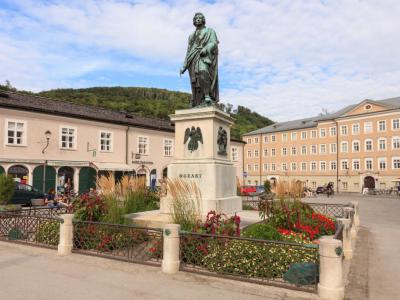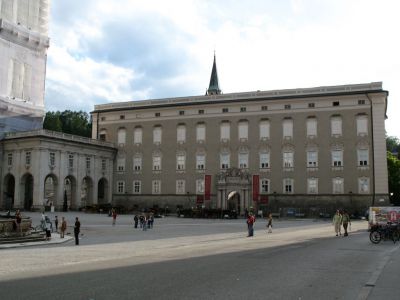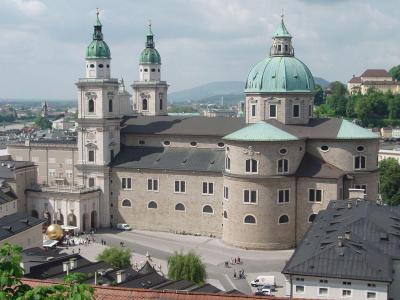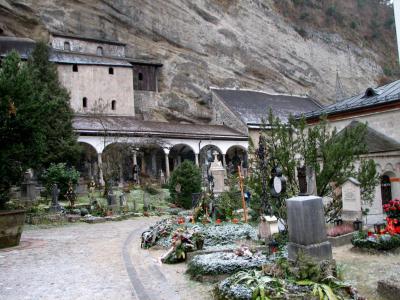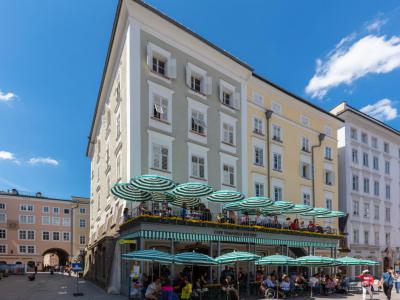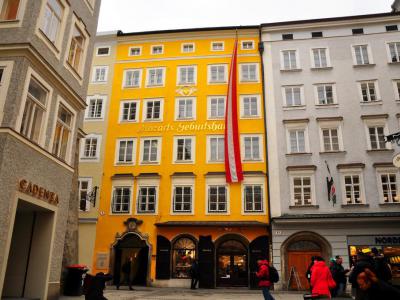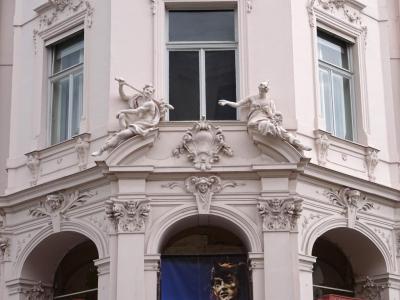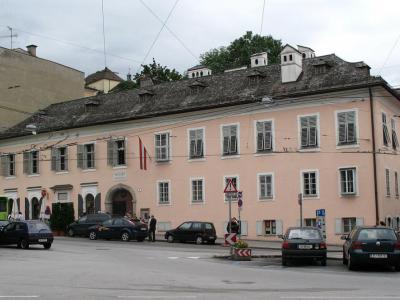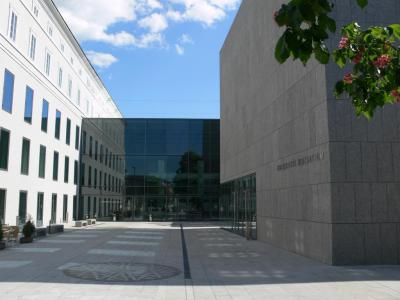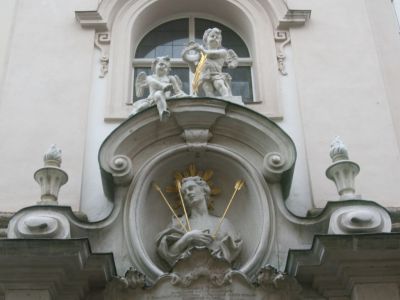
Mozart Walking Tour (Self Guided), Salzburg
Salzburg was Mozart's home throughout most of his short life. For those who wish to immerse themselves in the Mozart world, there are several locations in the city well worth exploring.
Born on Grain Street (Getreidegasse) and baptized in the nearby Cathedral, Mozart played his first big concert, at age 6, at the Residence Palace.
Later, he served as an organist for the Cathedral, conducted the Prince-Archbishop's orchestra, and used to dine at what is now called Café Tomaselli.
It was from Salzburg that Mozart toured Europe to gain international fame. At age 17, he and his family moved into lavish digs, presently known as Mozart's Residence (Mozart Wohnhaus).
Nowadays, Mozart Square (Mozartplatz), one of Salzburg's central hubs, features a statue of Mozart, paying homage to the great composer.
In his early years in Salzburg, Mozart composed the Dominikus Mass and later conducted his monumental "Mass in C minor" at Saint Peter's Abbey.
The Marionette Theater in Salzburg often features Mozart's operas performed by marionettes, a unique and delightful experience, while the Mozarteum University offers a chance to visit the so-called "Magic Flute House" and learn its fascinating story.
The Mozart family frequented Saint Sebastian's Church for Catholic mass due to its proximity to their home. Many members of the Mozart family, including his father and wife, are buried in the church's graveyard.
The legendary composer left an indelible mark on Salzburg, and his presence is still very much felt here. To truly appreciate Mozart's legacy, take this self-guided tour and get enchanted by the melodies of Mozart's life in this beautiful Austrian city.
Born on Grain Street (Getreidegasse) and baptized in the nearby Cathedral, Mozart played his first big concert, at age 6, at the Residence Palace.
Later, he served as an organist for the Cathedral, conducted the Prince-Archbishop's orchestra, and used to dine at what is now called Café Tomaselli.
It was from Salzburg that Mozart toured Europe to gain international fame. At age 17, he and his family moved into lavish digs, presently known as Mozart's Residence (Mozart Wohnhaus).
Nowadays, Mozart Square (Mozartplatz), one of Salzburg's central hubs, features a statue of Mozart, paying homage to the great composer.
In his early years in Salzburg, Mozart composed the Dominikus Mass and later conducted his monumental "Mass in C minor" at Saint Peter's Abbey.
The Marionette Theater in Salzburg often features Mozart's operas performed by marionettes, a unique and delightful experience, while the Mozarteum University offers a chance to visit the so-called "Magic Flute House" and learn its fascinating story.
The Mozart family frequented Saint Sebastian's Church for Catholic mass due to its proximity to their home. Many members of the Mozart family, including his father and wife, are buried in the church's graveyard.
The legendary composer left an indelible mark on Salzburg, and his presence is still very much felt here. To truly appreciate Mozart's legacy, take this self-guided tour and get enchanted by the melodies of Mozart's life in this beautiful Austrian city.
How it works: Download the app "GPSmyCity: Walks in 1K+ Cities" from Apple App Store or Google Play Store to your mobile phone or tablet. The app turns your mobile device into a personal tour guide and its built-in GPS navigation functions guide you from one tour stop to next. The app works offline, so no data plan is needed when traveling abroad.
Mozart Walking Tour Map
Guide Name: Mozart Walking Tour
Guide Location: Austria » Salzburg (See other walking tours in Salzburg)
Guide Type: Self-guided Walking Tour (Sightseeing)
# of Attractions: 10
Tour Duration: 2 Hour(s)
Travel Distance: 2.4 Km or 1.5 Miles
Author: julian
Sight(s) Featured in This Guide:
Guide Location: Austria » Salzburg (See other walking tours in Salzburg)
Guide Type: Self-guided Walking Tour (Sightseeing)
# of Attractions: 10
Tour Duration: 2 Hour(s)
Travel Distance: 2.4 Km or 1.5 Miles
Author: julian
Sight(s) Featured in This Guide:
- Mozartplatz (Mozart Square)
- Residence Palace (Residenz)
- Salzburg Cathedral (Salzburger Dom)
- St. Peter's Abbey and Cemetery
- Café Tomaselli
- Mozart's Birthplace (Mozarts Geburtshaus)
- Marionette Theater
- Mozart Residence (Mozart Wohnhaus)
- Mozarteum University / Magic Flute House
- St. Sebastian Church and Cemetery
1) Mozartplatz (Mozart Square) (must see)
The great composer, Wolfgang Amadeus Mozart, spent most of his first 25 years (1756-81) in Salzburg; in fact, he was born just a few blocks from this square (so having it named for someone else would have been rather scandalous!). He and his father both served Salzburg's rulers before Wolfgang grew restless and went on to seek a better position in Vienna.
Constructed at a time when the city was economically depressed because of the Napoleonic Wars, the statue was unveiled in 1842, just after the 50th anniversary of Mozart's death, in the presence of the composer's two surviving sons. It was the first sign of public recognition the great composer had received from his hometown since his untimely passing. The music festival held that year sowed the seed for what would become the now world-renowned annual Salzburg Festival.
Tip:
Aside from the many small shops/restaurants and several cafés nearby, you will also find the Salzburg Museum, while those looking to buy tacky souvenirs should check out the Zum Mozart located at the other corner of the square.
Constructed at a time when the city was economically depressed because of the Napoleonic Wars, the statue was unveiled in 1842, just after the 50th anniversary of Mozart's death, in the presence of the composer's two surviving sons. It was the first sign of public recognition the great composer had received from his hometown since his untimely passing. The music festival held that year sowed the seed for what would become the now world-renowned annual Salzburg Festival.
Tip:
Aside from the many small shops/restaurants and several cafés nearby, you will also find the Salzburg Museum, while those looking to buy tacky souvenirs should check out the Zum Mozart located at the other corner of the square.
2) Residence Palace (Residenz) (must see)
At the very heart of Salzburg's baroque historic district, the Residence Palace overlooks the spacious Residenzplatz and its famous marble fountain. The palace in its present form was built at the turn of the 17th century as the home of Wolf-Dietrich, the most powerful among the city's prince-archbishops. The sumptuous chambers and halls, along with the Residenz Gallery, with its magnificent cross-section of European painters from the 16th to 19th centuries (including Rembrandt, Rubens, and Brueghel), demonstrate the power of the church in Salzburg and are now integrated into one continuous tour of the building complex. The palace courtyard has been the lovely setting for Salzburg Festival opera productions since the 1950s; a good place to discover Mozart's lesser-known treasures.
***MOZART WALKING TOUR***
It was in the state rooms of the Residenz that Wolfgang Amadeus first performed for Salzburg's Archbishop, and he often did duty in the palace in his teens. At age 14, he became the first violinist of the court orchestra, while at age 19, his violin concert KV 219 in A major was performed for the first time in the Conference Hall. The prodigy's childhood violin, as well as his concert violin, his clavichord, and the pianoforte, are on display in the Mozart Residence (Wohnhaus).
Why You Should Visit:
One of the best historical attractions near the city center – a journey back into the days of the prince-archbishops. You get an audio guide and can visit many rooms of the palace (audience rooms, ballrooms, private rooms, etc.) while also enjoying a great aerial view of the square below.
Tip:
Admission for the Residenz and the DomQuartier is included in the Salzburg Card if you buy online before visiting. The tour can take 2 to 3 hours if you listen to the complete overview.
***MOZART WALKING TOUR***
It was in the state rooms of the Residenz that Wolfgang Amadeus first performed for Salzburg's Archbishop, and he often did duty in the palace in his teens. At age 14, he became the first violinist of the court orchestra, while at age 19, his violin concert KV 219 in A major was performed for the first time in the Conference Hall. The prodigy's childhood violin, as well as his concert violin, his clavichord, and the pianoforte, are on display in the Mozart Residence (Wohnhaus).
Why You Should Visit:
One of the best historical attractions near the city center – a journey back into the days of the prince-archbishops. You get an audio guide and can visit many rooms of the palace (audience rooms, ballrooms, private rooms, etc.) while also enjoying a great aerial view of the square below.
Tip:
Admission for the Residenz and the DomQuartier is included in the Salzburg Card if you buy online before visiting. The tour can take 2 to 3 hours if you listen to the complete overview.
3) Salzburg Cathedral (Salzburger Dom) (must see)
The keynote edifice of the cityscape, with its fabulous dome and pair of landmark towers, Salzburger Dom presents a breathtaking vista. Markus Sitticus, one of the most famous of the lengthy line of Prince Archbishops, was instrumental in taking the Baroque beauty – his center of power – to near completion. In the gloriously exquisite genre, the ornateness outside is a promise of what's in store within.
With an awe-inspiring vision along the vast nave, the eye is drawn to the altar and choir. A depiction of Jesus's resurrection is the centerpiece of the former, while sculptures of saints sit atop. A number of organs are to be admired, one on each side of the high altar and a magnificent one in the rear traditional placing. Definitely take a minute to sit in a pew and absorb everything around – you won't be disappointed.
The grand bronze baptismal font, just to the left upon entering, famously was used for the baptism of not only Mozart but also the creator of "Silent Night", Joseph Mohr.
Why You Should Visit:
Absolutely massive, incredibly ornate, free (although they ask for a donation), and very welcoming towards all kinds of people including tourists. Cameras are allowed and there are some excellent photo opportunities to be had.
Tip:
Take a downward trip to the crypt – there is as much underground as above.
Worth attending a Sunday mass at 10am, as you get a full orchestra and chorus.
With an awe-inspiring vision along the vast nave, the eye is drawn to the altar and choir. A depiction of Jesus's resurrection is the centerpiece of the former, while sculptures of saints sit atop. A number of organs are to be admired, one on each side of the high altar and a magnificent one in the rear traditional placing. Definitely take a minute to sit in a pew and absorb everything around – you won't be disappointed.
The grand bronze baptismal font, just to the left upon entering, famously was used for the baptism of not only Mozart but also the creator of "Silent Night", Joseph Mohr.
Why You Should Visit:
Absolutely massive, incredibly ornate, free (although they ask for a donation), and very welcoming towards all kinds of people including tourists. Cameras are allowed and there are some excellent photo opportunities to be had.
Tip:
Take a downward trip to the crypt – there is as much underground as above.
Worth attending a Sunday mass at 10am, as you get a full orchestra and chorus.
4) St. Peter's Abbey and Cemetery (must see)
Dating from the late 690s and still extant, St. Peter's offers much to view and contemplate. Forming part of the oldest functioning monastery in Austria, it also houses the country's oldest library and oldest restaurant, the entrance to which is adjacent to the church on the voluminous square that houses the Abbey monks and the administrative offices. "Community", a terrific wooden sculpture by Tyrolean artist Lackner Ferdinand is adjacent to the energetic water mill wheel.
A marvelous steeple crowned with an onion dome gives an admirable facade to the Abbey Church. Inside is a harmony of Rococo adornment, with a breathtaking vista through the nave. Decorative columns and arches take the view to the glorious altar area which should not be missed. It has been said that this Abbey was the birth of Christianity, being established just two centuries after the fall of the Roman Empire. You can certainly feel the history inside.
The abbey complex also contains a very old but interesting (and beautifully maintained) cemetery that features decorative gravestones and vaults keeping the remains and memories of many famous personages, including the architect Santino Solari who designed the nearby Dom/Cathedral, Mozart's sister Nannerl (an accomplished musician in her own right), and Joseph Haydn's brother, Michael.A steep stone stairway leads to early Christian catacombs incorporating two stone churches rendered from caves on the berg. Wonderful to visit, they are filled with early altars, faded murals and inscriptions.
***MOZART WALKING TOUR***
During Wolfgang's early years in Salzburg, Abbot Dominikus Hagenauer administrated St. Peter's church and monastery. Hagenauer celebrated his first mass here in October 1769, and Mozart composed the Dominikus Mass, KV 66 for this festive occasion. Hagenauer wrote in his diary, "Music for the Mass composed by Wolfgang Mozart, 14 years of age, which in every one's opinion was most elegant. Wolfgang Mozart played on the great organ for half an hour to the astonishment of all." The youngster would soon venture out to conquer the musical world; however, he specifically returned to St. Peter's fourteen years later, in October 1783, to conduct a performance of his monumental "Mass in C minor". Though it was the sole performance during his lifetime, the Salzburg Festival now performs the mass here every summer.
***SOUND OF MUSIC TOUR***
Toward the end of "The Sound of Music" film, the Von Trapps hide from the Nazis that wield flashlights behind the tombs in Nonnburg Convent's cemetery. The real Nonnburg cemetery, however, is extremely small and modest, so the filmmakers instead decided to use the Saint Peter's picturesque cemetery (Petersfriedhof) for the inspiration to build a Hollywood set where the actual filming took place. Ringing the edges of the flower-filled cemetery are large crypts for the local wealthy families enclosed within elegant wrought iron gates which are expertly reproduced in the movie.
While the real-life Von Trapps never hid in a cemetery, the scene and the confrontation with Rolf adds a great deal of drama to the plot, which is somewhat different from the original Broadway play produced in 1959.
Why You Should Visit:
Everything is free to visit except for the catacombs which cost not very much at all.
A marvelous steeple crowned with an onion dome gives an admirable facade to the Abbey Church. Inside is a harmony of Rococo adornment, with a breathtaking vista through the nave. Decorative columns and arches take the view to the glorious altar area which should not be missed. It has been said that this Abbey was the birth of Christianity, being established just two centuries after the fall of the Roman Empire. You can certainly feel the history inside.
The abbey complex also contains a very old but interesting (and beautifully maintained) cemetery that features decorative gravestones and vaults keeping the remains and memories of many famous personages, including the architect Santino Solari who designed the nearby Dom/Cathedral, Mozart's sister Nannerl (an accomplished musician in her own right), and Joseph Haydn's brother, Michael.A steep stone stairway leads to early Christian catacombs incorporating two stone churches rendered from caves on the berg. Wonderful to visit, they are filled with early altars, faded murals and inscriptions.
***MOZART WALKING TOUR***
During Wolfgang's early years in Salzburg, Abbot Dominikus Hagenauer administrated St. Peter's church and monastery. Hagenauer celebrated his first mass here in October 1769, and Mozart composed the Dominikus Mass, KV 66 for this festive occasion. Hagenauer wrote in his diary, "Music for the Mass composed by Wolfgang Mozart, 14 years of age, which in every one's opinion was most elegant. Wolfgang Mozart played on the great organ for half an hour to the astonishment of all." The youngster would soon venture out to conquer the musical world; however, he specifically returned to St. Peter's fourteen years later, in October 1783, to conduct a performance of his monumental "Mass in C minor". Though it was the sole performance during his lifetime, the Salzburg Festival now performs the mass here every summer.
***SOUND OF MUSIC TOUR***
Toward the end of "The Sound of Music" film, the Von Trapps hide from the Nazis that wield flashlights behind the tombs in Nonnburg Convent's cemetery. The real Nonnburg cemetery, however, is extremely small and modest, so the filmmakers instead decided to use the Saint Peter's picturesque cemetery (Petersfriedhof) for the inspiration to build a Hollywood set where the actual filming took place. Ringing the edges of the flower-filled cemetery are large crypts for the local wealthy families enclosed within elegant wrought iron gates which are expertly reproduced in the movie.
While the real-life Von Trapps never hid in a cemetery, the scene and the confrontation with Rolf adds a great deal of drama to the plot, which is somewhat different from the original Broadway play produced in 1959.
Why You Should Visit:
Everything is free to visit except for the catacombs which cost not very much at all.
5) Café Tomaselli
Every European city has what can be referred to as "the posh-café" – the one with the history and the elevated prices. It can usually be relied upon to deliver a minimum standard and your experience will be formed by a combination of ambience, service, and the final bill. Tomaselli is the main contender for Salzburg's "posh-café", with a long and distinguished history going back to 1700, allied to a good reputation and a superb location. On the whole, it could easily be viewed as one of the city's best, especially in summer when it can spread out into the Alter Markt, making for a perfect people-watching spot.
Ideally, take a book of Stefan Zweig, go to Tomaselli, have one of their delicious coffees and pastries, and relax. One aspect here is the waitress who roams around with a tray of the most delicious-looking confectionery (only the ladies serve the pastries, while men serve the drinks). Approaching tables and having people choose from a complete selection of cakes that are available has to be preferable to having them hover around the chiller-cabinet, getting bamboozled by a never-ending choice of patisserie items. Just a bit of a nice tradition!
***MOZART WALKING TOUR***
A frequent guest of the establishment, Wolfgang Amadeus used to have his almond milk at this very café when he was young. In 1852 Johanna Staiger sold the café to the "confectioner" Carl Tomaselli , the son of tenor Giuseppe Tomaselli from Milan, who enjoyed a close relationship with the composer's family, playing music with his father Leopold and his sister Nannerl, attending theatre performances with them, and also acting with them alongside other mutual friends. In the hands of Carl Tomaselli, the café became renowned far beyond the borders of Salzburg. Wolfgang's widow, remarried Constanze von Nissen, also lived in the building between 1820-26.
Ideally, take a book of Stefan Zweig, go to Tomaselli, have one of their delicious coffees and pastries, and relax. One aspect here is the waitress who roams around with a tray of the most delicious-looking confectionery (only the ladies serve the pastries, while men serve the drinks). Approaching tables and having people choose from a complete selection of cakes that are available has to be preferable to having them hover around the chiller-cabinet, getting bamboozled by a never-ending choice of patisserie items. Just a bit of a nice tradition!
***MOZART WALKING TOUR***
A frequent guest of the establishment, Wolfgang Amadeus used to have his almond milk at this very café when he was young. In 1852 Johanna Staiger sold the café to the "confectioner" Carl Tomaselli , the son of tenor Giuseppe Tomaselli from Milan, who enjoyed a close relationship with the composer's family, playing music with his father Leopold and his sister Nannerl, attending theatre performances with them, and also acting with them alongside other mutual friends. In the hands of Carl Tomaselli, the café became renowned far beyond the borders of Salzburg. Wolfgang's widow, remarried Constanze von Nissen, also lived in the building between 1820-26.
6) Mozart's Birthplace (Mozarts Geburtshaus) (must see)
In 1747, Leopold Mozart – a musician of not inconsiderable talent, who held the post of Vice-Capellmeister at the Prince-Archbishop's court – moved into this small rental unit with his new bride, Anna Maria Pertlin, a foster-child of the Convent of St. Gilgen. They soon had a baby girl (Nannerl), and on 27 January 1756, a little boy – baptized as Johannes Chrysostomus Wolfgangus Theophilus Mozart – was born. Music was honored in this simple home, where the little ones learned to play piano, harpsichord and violin, and where Wolfgang composed his first boy-genius works. The parents were filled with joy that heaven had granted them such blessings in both their children. Even after they gained fame, touring Europe's palaces and becoming the toast of Salzburg, they continued living in this rather cramped apartment in the Hagenauerhaus, as Leopold had no means other than the modest salary received from the Court.
Today, the 12th-century Hagenauerhaus is the most popular Mozart sight in town; for Mozart's admirers, it's almost a pilgrimage. Shuffling through with the crowds, you'll peruse three floors of rooms displaying paintings, correspondence, personal items, and lots of context, all giving a rich evocation of the Mozart family's life in the mid-18th century. Musical instruments chart the child genius's composing talents, with temporary themed Mozart-related exhibitions being also held.
Tip:
Salzburg Card users need not join the long ticket queue. If planning to go to the Mozart Residence (a 5-minute walk away) as well, there is a special reduced-price ticket for both museums. Do visit the gift shop, either way, as it has some unique and interesting souvenirs for those caring to look a little closer.
Today, the 12th-century Hagenauerhaus is the most popular Mozart sight in town; for Mozart's admirers, it's almost a pilgrimage. Shuffling through with the crowds, you'll peruse three floors of rooms displaying paintings, correspondence, personal items, and lots of context, all giving a rich evocation of the Mozart family's life in the mid-18th century. Musical instruments chart the child genius's composing talents, with temporary themed Mozart-related exhibitions being also held.
Tip:
Salzburg Card users need not join the long ticket queue. If planning to go to the Mozart Residence (a 5-minute walk away) as well, there is a special reduced-price ticket for both museums. Do visit the gift shop, either way, as it has some unique and interesting souvenirs for those caring to look a little closer.
7) Marionette Theater
One of the world's oldest puppet theaters in continuous operation, the Salzburger Marionetten has become popular with foreign tourists after being featured in the song, 'The Lonely Goatherd' from the 1965 Hollywood musical, 'The Sound of Music'. Established in 1913, it is a completely unique experience that enchants adults and children alike. Between 20 and 90 puppets are used for each performance, their charm expertly and realistically conveyed by their masters. With an ornate, richly decorated auditorium that incorporates grand lighting, cherubs aplenty and glamorous plaster work, the evening shows here are always authentic and memorable. You get a good view from anywhere, but it is better to pay more and get closer to the front so you can see the details in the marionettes and appreciate the skill with which they are worked.
***MOZART WALKING TOUR***
Many of Mozart's famous operas are in the repertoire, including 'Bastien and Bastienne' (with which the theater debuted in 1913) or the celebrated 'Magic Flute' which can be interpreted on so many levels, as it thinly disguises the major questions of the late 18th century. Why is a prince fit to rule? What is the role of the common man? Why is wisdom so important in a prince? Why is finding love so important? etc. etc.
Why You Should Visit:
The craftsmanship of the marionettes themselves and the artistry of the puppeteers who truly bring them to life in front of you are simply amazing! Expectations of tackiness are surpassed by professional and artful productions in a suitable setting.
Tip:
There are English subtitles to explain what's going on, but it doesn't hurt to be well versed in the story before attending.
***MOZART WALKING TOUR***
Many of Mozart's famous operas are in the repertoire, including 'Bastien and Bastienne' (with which the theater debuted in 1913) or the celebrated 'Magic Flute' which can be interpreted on so many levels, as it thinly disguises the major questions of the late 18th century. Why is a prince fit to rule? What is the role of the common man? Why is wisdom so important in a prince? Why is finding love so important? etc. etc.
Why You Should Visit:
The craftsmanship of the marionettes themselves and the artistry of the puppeteers who truly bring them to life in front of you are simply amazing! Expectations of tackiness are surpassed by professional and artful productions in a suitable setting.
Tip:
There are English subtitles to explain what's going on, but it doesn't hurt to be well versed in the story before attending.
8) Mozart Residence (Mozart Wohnhaus) (must see)
A large painting of the family shows the prodigy with his father on the violin and his sister at the piano, while the mother – who had sadly died two years earlier in Paris – is portrayed separately above the threesome. Elsewhere, you'll see three circular targets high on the wall and – in the glass case nearby – the air rifle that the Mozarts used to shoot at them. These are just some of the marvelous artifacts in the rooms, to which the Mozart family moved in 1773 as their place in Hagenauerhaus was no longer adequate for their needs. It was here, in the spacious apartment on the first floor, that the Mozart family would host social gatherings appropriately and where Wolfgang himself stayed until he moved to Vienna in 1781. Damaged during a WWII air raid and consequently restored, the building was converted into a museum by the Mozart Foundation and opened to the public in 1996.
Highlights include a screen presentation of Mozart's extensive travels in Europe initiated by his father, who was convinced they were essential to enlighten and humanize his prodigy son. In another room, you might be interested in the audio guide's explanation of how Leopold helped to immerse Wolfgang in playing music and later promoted his talented son. The last room has extensive information about how the "Mozart" name has been used for profit, and the one before it shows fraudulent portraits of Mozart throughout the years.
Daily: 9am–5:30pm (Sep–Jun); 8:30–7pm (Jul–Aug)
Last admission 30 mins before closing
Highlights include a screen presentation of Mozart's extensive travels in Europe initiated by his father, who was convinced they were essential to enlighten and humanize his prodigy son. In another room, you might be interested in the audio guide's explanation of how Leopold helped to immerse Wolfgang in playing music and later promoted his talented son. The last room has extensive information about how the "Mozart" name has been used for profit, and the one before it shows fraudulent portraits of Mozart throughout the years.
Daily: 9am–5:30pm (Sep–Jun); 8:30–7pm (Jul–Aug)
Last admission 30 mins before closing
9) Mozarteum University / Magic Flute House
Along with the International Mozarteum Foundation and the Mozarteum Orchestra Salzburg, the Mozarteum University is a separate entity under the "Mozarteum" moniker, with "Mozart is our inspiration, music our tradition, art our passion" as a motto. If you happen to be in Salzburg in July and August when the Mozarteum organizes events in the adjacent Grand Hall (or Großer Saal), you might be able to visit the so-called "Magic Flute House" (or "Zauberflötenhäuschen"), the little summerhouse where Mozart was allegedly locked in by his librettist, Emanuel Schikaneder, to ensure that he would finish the now-famous composition on time. Transported to Salzburg from its original location in Vienna, the house was much visited by the faithful, who would snatch shingles off its roof. It had to be restored several times, especially after the Second World War, when the structure suffered a considerable amount of damage during the bombing of the city.
Tip:
Attend a concert in the Stiftung Mozarteum if you can – you won't be disappointed.
Tip:
Attend a concert in the Stiftung Mozarteum if you can – you won't be disappointed.
10) St. Sebastian Church and Cemetery
The original Catholic church of Saint Sebastian in Salzburg was built between 1505 and 1512. What stands in its place now is the 18th-century remake by Austrian architect and stuccoist, Kassian Singer, dating from 1749-1753. The building features Late Baroque style with some Rococo elements, including the magnificent portal and impressive gate separating the entrance porch from the main nave. The high altar is adorned with a wonderful Madonna with Child, created in 1611.
In 1818 the church was ravaged by fire that consumed a beautiful ceiling fresco and the high altar painting by Paul Troger. During the ensued restoration, the charred Baroque paintings were replaced and the Sebastian relief, made by Konrad Asper between 1614 and 1620, was added to the outer façade.
***Mozart Walking Tour***
Given its proximity to their Wohnaus residence, the Mozart family often visited St Sebastian's for Catholic mass. Today, the mass here is still served entirely in Latin.
Many of the Mozarts are buried at the church's cemetery, including Wolfgang’s father Leopold and wife Constanze, his maternal grandmother Eva Rosina Pertl (1755), and Constanze’s second husband Georg Nikolaus Nissen (1826). Mozart’s two sisters-in-law, Aloysia Lange and Sophie Haibel, were also buried here but were later exhumed and re-buried at the Salzburg municipal cemetery.
The St Sebastian cemetery was designed by Prince-Archbishop Wolf Dietrich von Raitenau between 1595 and 1600, inspired by the Italian Campo Santo (“sacred field”). In the middle of the central square, surrounded by arcades, is the brightly tiled mannerist mausoleum of Archbishop Wolf Dietrich himself. Since 1564, a passageway leading to the cemetery has also been home to the tomb of famous Swiss scientist and scholar Theophrastus Bombastus von Hohenheim, better known as "Paracelsus".
Tip:
Don't miss the amazing catacombs set high in the rocks!
In 1818 the church was ravaged by fire that consumed a beautiful ceiling fresco and the high altar painting by Paul Troger. During the ensued restoration, the charred Baroque paintings were replaced and the Sebastian relief, made by Konrad Asper between 1614 and 1620, was added to the outer façade.
***Mozart Walking Tour***
Given its proximity to their Wohnaus residence, the Mozart family often visited St Sebastian's for Catholic mass. Today, the mass here is still served entirely in Latin.
Many of the Mozarts are buried at the church's cemetery, including Wolfgang’s father Leopold and wife Constanze, his maternal grandmother Eva Rosina Pertl (1755), and Constanze’s second husband Georg Nikolaus Nissen (1826). Mozart’s two sisters-in-law, Aloysia Lange and Sophie Haibel, were also buried here but were later exhumed and re-buried at the Salzburg municipal cemetery.
The St Sebastian cemetery was designed by Prince-Archbishop Wolf Dietrich von Raitenau between 1595 and 1600, inspired by the Italian Campo Santo (“sacred field”). In the middle of the central square, surrounded by arcades, is the brightly tiled mannerist mausoleum of Archbishop Wolf Dietrich himself. Since 1564, a passageway leading to the cemetery has also been home to the tomb of famous Swiss scientist and scholar Theophrastus Bombastus von Hohenheim, better known as "Paracelsus".
Tip:
Don't miss the amazing catacombs set high in the rocks!
Walking Tours in Salzburg, Austria
Create Your Own Walk in Salzburg
Creating your own self-guided walk in Salzburg is easy and fun. Choose the city attractions that you want to see and a walk route map will be created just for you. You can even set your hotel as the start point of the walk.
Salzburg Introduction Walking Tour
Dubbed the "City of Mozart", the enchanting Austrian city of Salzburg has gone down in history primarily as the hometown of its greatest son, Wolfgang Amadeus Mozart. His birthplace on Getreidegasse, a busy shopping street, is now a museum, much like the Mozart Residence, a place where the 18th-century composer spent much of his early life.
Apart from Mozart, however, Salzburg is also... view more
Tour Duration: 2 Hour(s)
Travel Distance: 2.8 Km or 1.7 Miles
Apart from Mozart, however, Salzburg is also... view more
Tour Duration: 2 Hour(s)
Travel Distance: 2.8 Km or 1.7 Miles
Sound of Music Tour
As the hometown of Mozart, Salzburg is a true mecca for music fans, with no shortage of visitors. In the past few decades, though, Salzburg's Old Town has gained international fame thanks to the Hollywood film "The Sound of Music," shot in 1965. Set on the eve of World War II, the movie follows the lead characters, the Von Trapp family and their nanny played by Julie Andrews, all... view more
Tour Duration: 2 Hour(s)
Travel Distance: 4.2 Km or 2.6 Miles
Tour Duration: 2 Hour(s)
Travel Distance: 4.2 Km or 2.6 Miles
Old Town Gift Shops
Specialty shops make up an integral part of tourist life in Salzburg. The picturesque Old Town of Salzburg boasts a delightful array of gift shops, all within a pleasant walking distance, offering a diverse range of souvenirs and local treasures. Let's take a stroll through some of the notable establishments in this historic area.
We start at Kirchtag, a quaint gift shop known for its... view more
Tour Duration: 1 Hour(s)
Travel Distance: 0.9 Km or 0.6 Miles
We start at Kirchtag, a quaint gift shop known for its... view more
Tour Duration: 1 Hour(s)
Travel Distance: 0.9 Km or 0.6 Miles
Historical Religious Buildings Walking Tour
The historic center of Salzburg, a UNESCO World Heritage Site since 1996, is home to numerous landmarks, including religious sites. Collectively, these historical sanctuaries, from small churches to the impressive Baroque-style Salzburg Cathedral, bear witness to the city's fascinating past and contribute a great deal of charm to its alluring present.
The local Saint Peter's Abbey is... view more
Tour Duration: 1 Hour(s)
Travel Distance: 1.4 Km or 0.9 Miles
The local Saint Peter's Abbey is... view more
Tour Duration: 1 Hour(s)
Travel Distance: 1.4 Km or 0.9 Miles
The Most Popular Cities
/ view all
